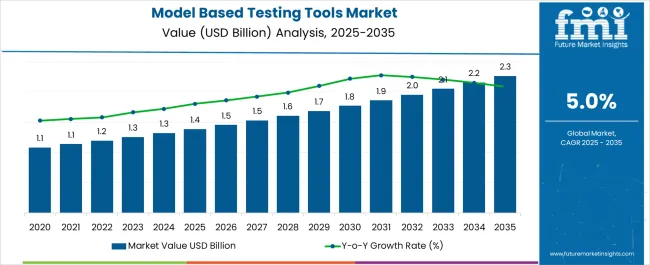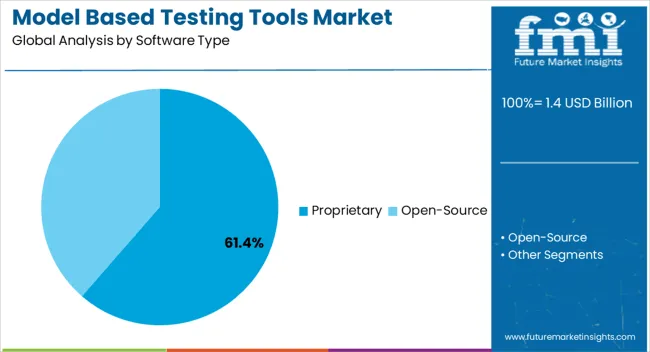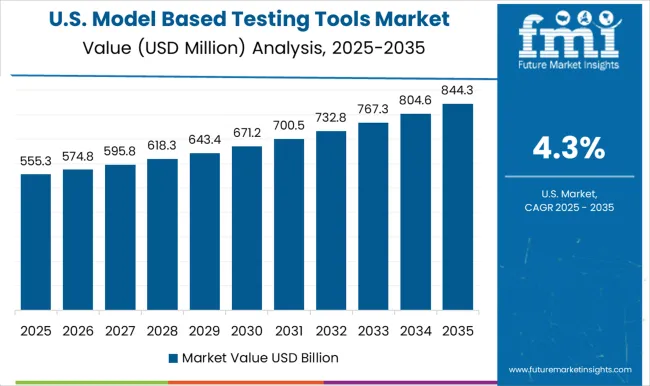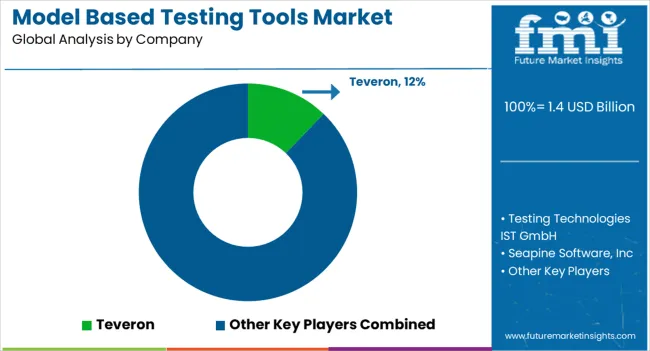The Model Based Testing Tools Market is estimated to be valued at USD 1.4 billion in 2025 and is projected to reach USD 2.3 billion by 2035, registering a compound annual growth rate (CAGR) of 5.0% over the forecast period.

| Metric | Value |
|---|---|
| Model Based Testing Tools Market Estimated Value in (2025 E) | USD 1.4 billion |
| Model Based Testing Tools Market Forecast Value in (2035 F) | USD 2.3 billion |
| Forecast CAGR (2025 to 2035) | 5.0% |
The model based testing (MBT) tools market is growing steadily, supported by the increasing demand for automated testing solutions that reduce development cycles and improve software quality. Industry publications and technology updates have emphasized the growing complexity of software systems, especially with the rise of AI, IoT, and embedded applications, which has necessitated the use of model-driven approaches. MBT tools allow developers and QA teams to generate test cases automatically from system models, improving accuracy while minimizing manual effort.
Technology vendors have continued to expand their MBT portfolios, integrating them with CI/CD pipelines and DevOps practices, making them more accessible for enterprise adoption. Additionally, corporate annual reports and investor briefings have highlighted strong spending on quality assurance solutions as enterprises seek to reduce costs related to defects and system failures.
The market outlook is further strengthened by regulatory requirements in sectors such as automotive, aerospace, and healthcare, where system reliability and compliance are critical. Looking ahead, advancements in AI-enhanced testing platforms and increasing adoption of cloud-based MBT solutions are expected to fuel long-term growth.

The Proprietary segment is projected to contribute 61.40% of the model based testing tools market revenue in 2025, establishing itself as the dominant software type. Growth in this segment has been driven by the advanced capabilities, security features, and technical support offered by proprietary MBT solutions. Enterprises have favored these tools due to their scalability, integration with enterprise software ecosystems, and ability to meet industry-specific compliance standards.
Proprietary platforms have also invested heavily in R&D, introducing features such as AI-driven test optimization, multi-platform support, and advanced reporting functionalities. Vendor-backed training, customer support, and regular updates have further reinforced enterprise confidence in proprietary tools, especially in mission-critical industries where downtime or errors carry high costs.
Additionally, long-term licensing agreements and bundled service packages have strengthened adoption rates among large organizations. With the continued prioritization of robust, enterprise-grade testing environments, the Proprietary segment is expected to sustain its leadership in the MBT tools market.
A historical analysis of the model based testing tools market from 2020 to 2025 reveals a remarkable evolution in the field of software testing. During this period, the industry saw a significant shift toward test generation from models. This approach allowed organizations to streamline their test automation life cycle by creating test cases directly from visual models, reducing manual efforts and enhancing efficiency.
The benefits of model-based testing (MBT) became increasingly evident. It not only accelerated testing processes but also improved test coverage and accuracy, resulting in high-quality software products. Test automation technologies played a pivotal role in this transformation, enabling seamless integration of MBT into existing workflows.
Looking forward to 2025 to 2035, the model based testing tools market is poised for further growth. Forecast projections indicate that MBT is expected to continue to gain prominence as businesses recognize its potential to revolutionize software testing. This period is expected to witness sophisticated MBT tools and platforms, catering to the diverse needs of industries.
MBT market analysis suggests that the adoption of MBT is likely to become widespread, with organizations from various sectors embracing this approach to stay competitive in the significantly evolving tech landscape. As MBT becomes an integral part of software development and quality assurance, its impact on the industry is set to be transformative, shaping the future of testing methodologies.
The below table showcases revenues in terms of the top 5 leading countries, spearheaded by the United States and the United Kingdom.

In the United States, the model based testing tools market is experiencing a dynamic shift driven by several uncharted drivers. The rise of DevOps and Agile methodologies is steering organizations toward adopting model-based testing. These approaches emphasize continuous testing and rapid development, making MBT an indispensable component of the software development lifecycle.
Stringent regulatory requirements in sectors like healthcare and finance are propelling the demand for model-based testing. Organizations are turning to MBT to ensure compliance and maintain high standards of software quality.
The increasing complexity of software applications and the demand for robust cybersecurity measures are pushing companies to embrace MBT. Its ability to provide comprehensive test coverage and detect vulnerabilities early in the development process is a compelling incentive.
The integration of model-based testing with artificial intelligence (AI) and machine learning (ML) is transforming the market. AI-driven MBT tools are automating test case generation, predictive testing, and error detection, further elevating testing precision and efficiency.
The model-based testing tools market in the United Kingdom is teeming with latent opportunities, poised to reshape the testing landscape. A prominent avenue is the integration of MBT into regulatory compliance. With stringent quality standards in industries like finance and healthcare, MBT tools can streamline compliance testing, ensuring adherence to complex regulations while reducing manual effort.
There is a burgeoning demand for MBT solutions in the burgeoning field of IoT. As IoT devices multiply, MBT's ability to comprehensively test various scenarios becomes invaluable, guaranteeing seamless connectivity and functionality.
Personalized software and apps are driving the need for MBT tailored to individual user experiences. Tools that focus on user-centric testing, ensuring optimal performance, will gain prominence.
The United Kingdom's drive for sustainability opens doors for MBT in eco-friendly software testing, aiding companies in minimizing their environmental footprint.
The model-based testing tools market in China is experiencing a surge in innovation and adaptation, driven by both technological advancements and a growing demand for quality software. One notable trend is the localization of MBT tools, tailored to meet the unique needs of businesses in China. These tools incorporate Mandarin language support, making them accessible and user-friendly for local developers and testers.
There is a growing emphasis on cloud-based MBT solutions, enabling remote collaboration and scalability for organizations. This trend aligns with China's increasing reliance on cloud technology.
The market is witnessing a shift toward sector-specific MBT applications, such as those tailored for the booming e-commerce and fintech industries. This specialization optimizes testing processes for these domains, addressing their distinct challenges.
The model-based testing tools market in China is exploring innovative ways to integrate MBT with AI and machine learning, enhancing predictive testing capabilities. These advancements promise to elevate the quality of Chinese software products, positioning the nation as a key player in the global software-testing arena.
In Japan, model-based testing tools are experiencing a dynamic resurgence, driven by evolving trends that promise to reshape quality assurance in the tech industry. One prominent trend is the increased adoption of MBT tools in agile and DevOps environments. As companies in Japan strive for rapid software development cycles, MBT offers an ideal solution with its automated test generation capabilities.
There is a growing emphasis on real-time testing and monitoring, ensuring software reliability in complex systems. This shift is fueled by the demand for robust solutions in sectors like automotive, electronics, and IoT, where flawless performance is non-negotiable.
Japan's tech industry is witnessing a collaborative revolution, with MBT tools facilitating improved communication between developers and testers. This fosters an environment of shared responsibility, enhancing overall product quality. The prospects for model-based testing tools in Japan are indeed promising, with these trends reflecting the nation's commitment to innovation and high-quality software development.
South Korea is a leading player in the model based testing tools domain, drawing attention for its innovative strides in the field. With a thriving tech ecosystem and a commitment to cutting-edge research, companies in South Korea and institutions have made substantial contributions to the global model based testing tools market.
A key area of focus is the development of advanced testing methodologies and tools that align with the growing demand for efficient and precise software testing. South Korean firms are actively investing in model-based testing (MBT) to automate test case generation and enhance testing coverage, all while reducing human errors.
South Korea's dedication to quality assurance and its emphasis on leveraging MBT for critical industries like automotive and electronics underscore its commitment to excellence. As South Korea continues to nurture its talent pool and foster collaboration between academia and industry, it is likely to play an increasingly influential role in shaping the future of the model based testing tools landscape, both regionally and globally.
The below table highlights how open-source is projected to lead the market in terms of software type, expandng at 5.5% CAGR through 2035.
| Category | CAGR from 2025 to 2035 |
|---|---|
| Open-Source | 5.5% |
The open-source segment dominates the model based testing tools market due to its inherent advantages. Open-source tools offer cost-effectiveness, making them accessible to a broad user base.
Open-source tools foster collaboration, allowing developers to customize and improve tools, leading to rapid innovation. These tools often enjoy strong community support, ensuring timely updates and bug fixes. They promote transparency, instilling trust in users regarding the tool's functionality and security.
In a landscape where adaptability and flexibility are paramount, open-source solutions empower organizations to tailor their testing processes, making them a preferred choice and driving their dominance in the market.

The competitive landscape of the model based testing tools market is dynamic and evolving significantly. Established players and emerging startups are vying for market share, driving innovation and technological advancements. Key factors such as product capabilities, scalability, ease of integration, and customer support are critical in this fiercely competitive arena.
The adoption of artificial intelligence and machine learning within model based testing tools is reshaping the landscape, offering predictive testing and enhanced automation. As customer demands for efficiency and accuracy grow, competition is intensifying. It is compelling companies to continually refine their offerings and expand their global footprint to stay competitive in the thriving market.
| Attributes | Details |
|---|---|
| Estimated Market Size in 2025 | USD 1.4 billion |
| Projected Market Valuation in 2035 | USD 2.3 billion |
| Value-based CAGR 2025 to 2035 | 5.0% |
| Forecast Period | 2025 to 2035 |
| Historical Data Available for | 2020 to 2025 |
| Market Analysis | Value in USD million |
| Key Regions Covered | North America; Latin America; Western Europe; Eastern Europe; South Asia and Pacific; East Asia; The Middle East & Africa |
| Key Market Segments Covered | Software Type, Region |
| Key Countries Profiled | The United States, Canada, Brazil, Mexico, Germany, The United Kingdom, France, Spain, Italy, Russia, Poland, Czech Republic, Romania, India, Bangladesh, Australia, New Zealand, China, Japan, South Korea, GCC countries, South Africa, Israel |
| Key Companies Profiled | Teveron; Testing Technologies IST GmbH; Seapine Software, Inc.; Canam Software Labs, Inc.; SmarteSoft, Inc.; PractiTest Ltd.; Turbo computer systems; IBM Corporation; Logigear; Micro Focus; Tricentis (Austria); Seapine Software; HCL Technologies (India); Broadcom Inc.; Microsoft Corporation; Oracle; LogiGear and Software Testing Solutions Inc. |
The global model based testing tools market is estimated to be valued at USD 1.4 billion in 2025.
The market size for the model based testing tools market is projected to reach USD 2.3 billion by 2035.
The model based testing tools market is expected to grow at a 5.0% CAGR between 2025 and 2035.
The key product types in model based testing tools market are proprietary and open-source.
In terms of , segment to command 0.0% share in the model based testing tools market in 2025.






Full Research Suite comprises of:
Market outlook & trends analysis
Interviews & case studies
Strategic recommendations
Vendor profiles & capabilities analysis
5-year forecasts
8 regions and 60+ country-level data splits
Market segment data splits
12 months of continuous data updates
DELIVERED AS:
PDF EXCEL ONLINE
Model-Based Manufacturing Technologies Market Analysis by Solution, Deployment, Enterprise Size, Industry, and Region Through 2035
Animal Model Market Analysis - Size, Share, and Forecast Outlook 2025 to 2035
USA Animal Model Market Size and Share Forecast Outlook 2025 to 2035
Bathroom Remodeling Market Size and Share Forecast Outlook 2025 to 2035
Data Center Modeling and Simulation Tools Market
AI-Driven Agent-Based Modeling – Predictive Insights & Analysis
3D Mapping and Modeling Market Size and Share Forecast Outlook 2025 to 2035
Humanized Mouse Model Market Size and Share Forecast Outlook 2025 to 2035
3D Printed Brain Model Market Analysis – Trends & Forecast 2024-2034
Human Anatomical Models Market
Digital Elevation Model Market Size and Share Forecast Outlook 2025 to 2035
3D Printed Surgical Models Market Analysis - Size, Share, and Forecast 2025 to 2035
Building Information Modeling Market Size and Share Forecast Outlook 2025 to 2035
Tourism Independent Contractor Model Market Size and Share Forecast Outlook 2025 to 2035
Si-based Hall Effect Sensors Market Size and Share Forecast Outlook 2025 to 2035
Ph Based Lip Balm Market Size and Share Forecast Outlook 2025 to 2035
AI-Based Driving Systems (L2 to L5) Market Analysis - Size, Share, and Forecast Outlook 2025 to 2035
Biobased And Synthetic Polyamides Market Size and Share Forecast Outlook 2025 to 2035
AI-based Research Services Market Analysis Size and Share Forecast Outlook 2025 to 2035
AI-based Atrial Fibrillation AFib Detection Market Size and Share Forecast Outlook 2025 to 2035

Thank you!
You will receive an email from our Business Development Manager. Please be sure to check your SPAM/JUNK folder too.
Chat With
MaRIA